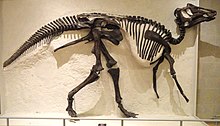
Back Prosaurolophus Catalan Prosaurolophus Czech Prosaurolophus German Prosaŭrolofo Esperanto Prosaurolophus Spanish پیشاخزندهتاج Persian Prosaurolophus French פרוזאורולופוס HE Prosaurolophus Croatian Prosaurolophus Hungarian
| Prosaurolophus Temporal range:
Late Cretaceous, | |
|---|---|

| |
| P. maximus specimen collected 1921, Royal Ontario Museum | |
| Scientific classification | |
| Domain: | Eukaryota |
| Kingdom: | Animalia |
| Phylum: | Chordata |
| Clade: | Dinosauria |
| Clade: | †Ornithischia |
| Clade: | †Neornithischia |
| Clade: | †Ornithopoda |
| Family: | †Hadrosauridae |
| Subfamily: | †Saurolophinae |
| Genus: | †Prosaurolophus Brown, 1916 |
| Species: | †P. maximus
|
| Binomial name | |
| †Prosaurolophus maximus Brown, 1916
| |
| Synonyms[1][2][3] | |
| |
Prosaurolophus (/ˌproʊsɔːˈrɒləfəs/; meaning "before Saurolophus", in comparison to the later dinosaur with a similar head crest) is a genus of hadrosaurid (or duck-billed) dinosaur from the Late Cretaceous of North America. It is known from the remains of at least 25 individuals belonging to two species, including skulls and skeletons, but it remains obscure. Its fossils have been found in the late Campanian-age Upper Cretaceous Dinosaur Park Formation in Alberta, and the roughly contemporaneous Two Medicine Formation in Montana, dating to around 75.5-74.0 million years ago. Its most recognizable feature is a small solid crest formed by the nasal bones, sticking up in front of the eyes.
The type species is P. maximus, described by American paleontologist Barnum Brown of the American Museum of Natural History in 1916. A second species, P. blackfeetensis, was described by Jack Horner of the Museum of the Rockies in 1992. The two species were differentiated mainly by crest size and skull proportions.
© MMXXIII Rich X Search. We shall prevail. All rights reserved. Rich X Search